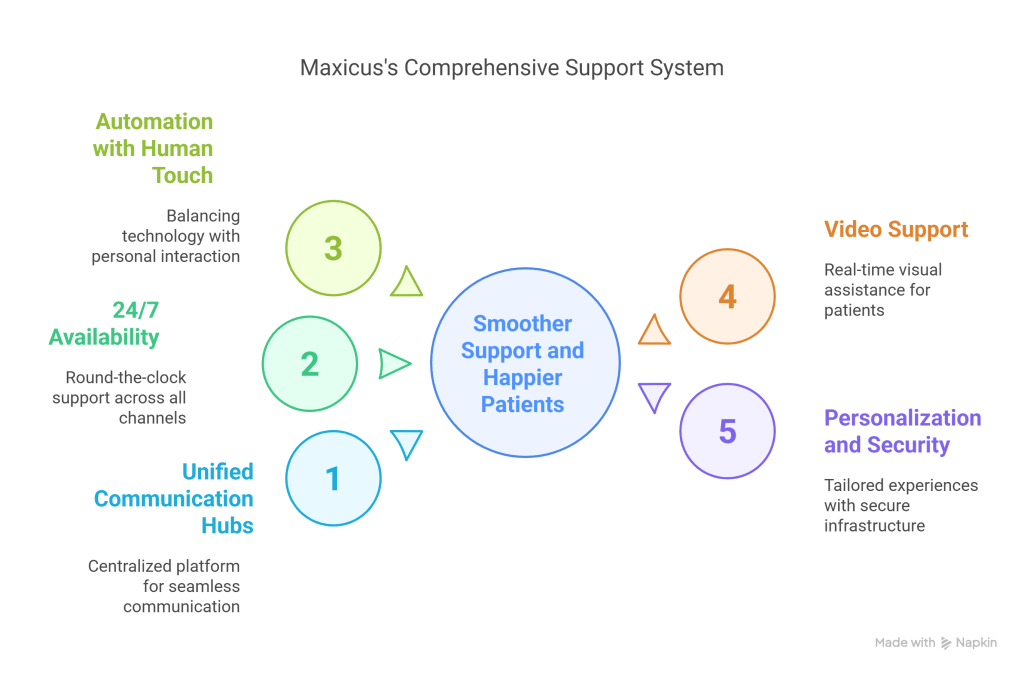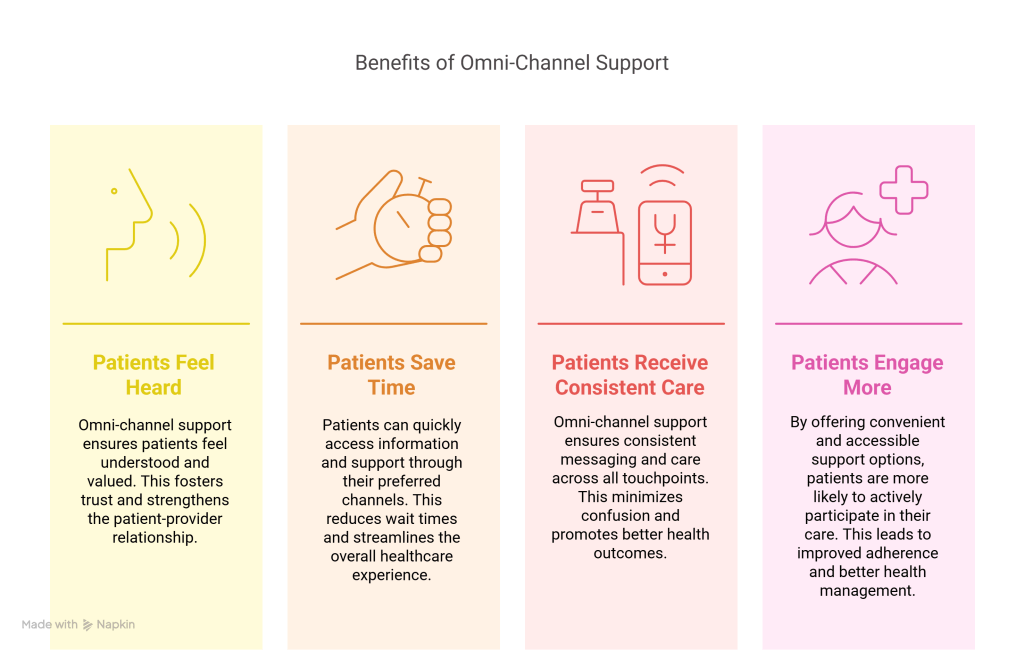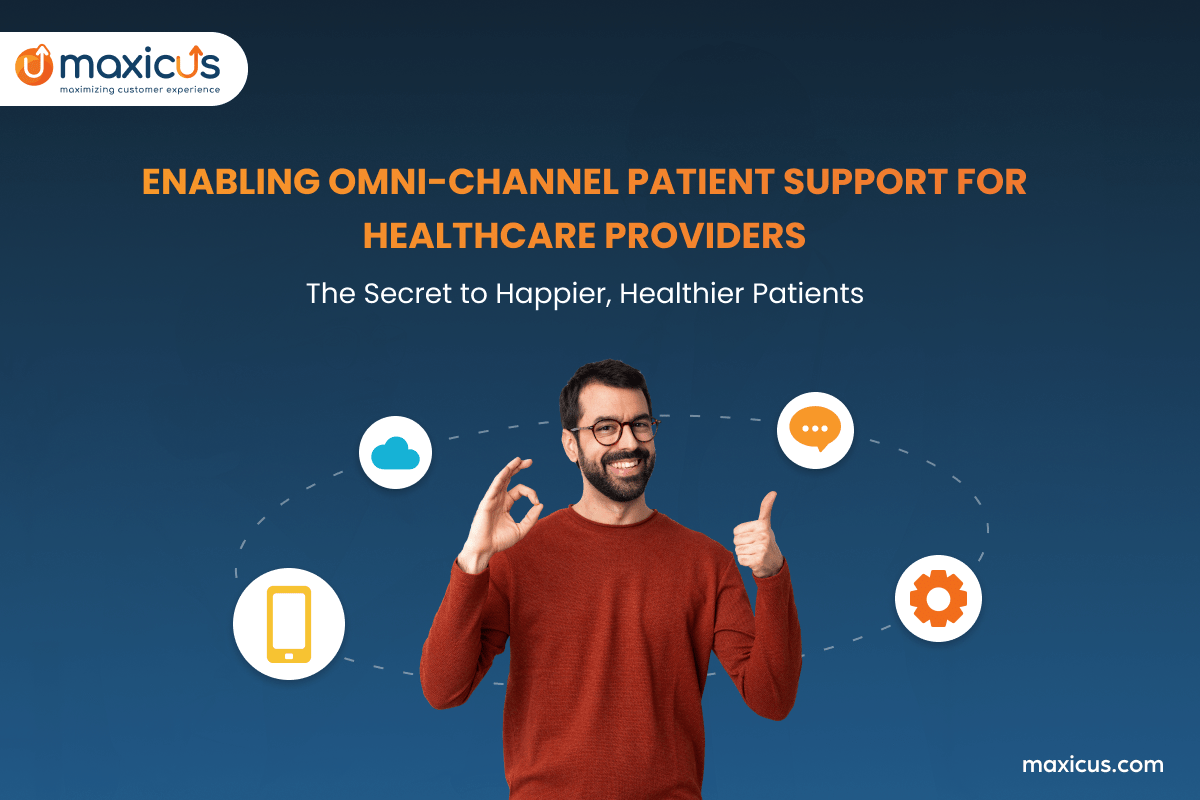Enabling Omni-Channel Patient Support for Healthcare Providers: The Secret to Happier, Healthier Patients
In today’s healthcare landscape, one truth has become increasingly clear: patients expect more than just quality care. They are proactive, digitally engaged individuals who demand the same level of convenience and personalized service from their healthcare providers as they do from their favorite online retailers.
This shift in patient behavior is compelling healthcare providers to rethink how they interact with patients—far beyond the clinical setting.
So, how can healthcare providers meet these expectations without exhausting their staff or compromising on quality care?
Enter omni-channel patient support—a powerful approach that integrates all communication channels into a unified system to deliver superior patient experiences.
At Maxicus, we ensure patients feel seen, heard, and cared for—no matter when, where, or how they choose to interact. And at the heart of it all? Satisfied patients.
The Modern Patient: Redefining Expectations in Healthcare
Today’s patients are digital-first. They browse symptoms on Google, compare providers online, and expect instant answers—whether it’s through WhatsApp, live chat, social media, or a phone call.
A missed message could mean a missed appointment—or worse, a missed opportunity to build trust. That’s why healthcare providers need to be where their patients are, without making the experience feel like a maze.
According to recent reports, 72% of patients prefer digital communication with healthcare providers over traditional methods.
Top Provider’s Success Story: Read the Case Study
What is Omni-Channel Patient Support?
Omni-channel patient support is a unified approach to patient communication. Whether a patient messages you on your website, emails about a prescription, or calls your helpline, an omni-channel support system ensures all those touchpoints connect seamlessly.
Unlike multi-channel communication, where each channel operates independently (phone, chat, email, social media, etc.), an omni-channel method merges them into a single ecosystem.
Here’s what that looks like in action:
- A patient chats with a bot on your website to inquire about flu symptoms.
- The same patient receives a call from a nurse to discuss care options.
- They schedule a telehealth appointment via email and get reminders.
- Post-appointment, follow-up advice and lab results are shared through a secure patient portal.
Throughout this journey, every interaction is informed by previous ones, eliminating redundancy and creating an exceptional experience.
No repetition. No confusion. Just frictionless care!
Maxicus: Powering Smoother Support, Happier Patients
Let’s see how we help healthcare providers deliver truly connected care experiences:

1. Unified Communication Hubs
At Maxicus, all patient interactions—voice, chat, or SMS—are integrated into a single platform. This allows support teams to access complete patient histories and provide personalized responses immediately.
No more switching between systems. No more lost context. Just informed, efficient communication.
2. 24/7 Availability Across Channels
Health doesn’t follow a 9-to-5 schedule. Patients may have questions at midnight, need urgent rescheduling in the early morning, or want follow-up info over the weekend.
With Maxicus’ omni-channel capabilities, your healthcare brand can be available around the clock, ensuring patients always have access to timely support—via their preferred channels.
Whether it’s a chatbot handling FAQs at 2 a.m. or a live agent guiding a patient through a billing query during lunch hours, we ensure no question goes unanswered.
3. Blending Automation with the Human Touch
Efficiency can be achieved with smart automation—but what about empathy?
Our hybrid model blends AI-powered chatbots for routine queries like appointment scheduling, prescription refills, or FAQs with skilled live agents who step in when a personal touch is required.
This balance ensures patients never feel like they’re “just a number” and helps reduce the burden on healthcare staff by handling repetitive tasks.
4. Video Support for Real-Time Care
In situations where seeing and hearing someone in real time makes all the difference, Maxicus enables secure video support. Whether it’s a virtual consultation or a short face-to-face to reduce patient anxiety, video brings the human touch.
Video-assisted support ensures faster issue resolution, builds trust, and makes healthcare more accessible.
Moreover, video can act as a competitive advantage, especially for elderly patients, rural communities, and those managing chronic conditions.
5. Personalization and Secure Infrastructure
Maxicus offers personalized communication by understanding patient behavior, preferences, and needs. Whether you’re a small clinic or a nationwide hospital network, Maxicus is the ultimate partner for your growth.
We also provide full compliance with HIPAA and other global health data requirements, recognizing that healthcare demands the highest levels of data privacy.
Why Omni-Channel Support Equals Satisfied Patients
When done right, omni-channel support does more than just streamline operations—it improves patient experiences, consequently enhancing satisfaction and health outcomes.

Let’s explain how:
Patients Feel Heard: Whether they contact you via chat, email, or phone, patients hate repeating themselves. Omni-channel support ensures that every touchpoint is informed by the last—making patients feel like their concerns are truly understood.
Patients Save Time: Patients can avoid unnecessary delays and misunderstandings by receiving fast information and engaging in proactive communication. Convenience generates trust, which builds satisfaction.
Patients Receive Consistent Care: Omni-channel communication ensures that all departments and providers are aligned, reducing miscommunication and improving the accuracy of care.
Patients Engage More: Engaged patients are more likely to follow treatment plans, attend appointments, and manage chronic conditions, leading to better long-term outcomes.
A Real-Life Scenario: Transforming the Patient Experience with Maxicus
Let’s look at a patient journey—before and after implementing omni-channel support with Maxicus:
Before Omni-Channel
- Patient calls to book an appointment and is on hold for 15 minutes.
- Receives a confirmation email—but forgets to check it.
- Misses the appointment and tries to reschedule via the website but can’t reach support.
- Must start over on the phone and explain everything again.
- Leaves feeling frustrated, unheard, and undervalued.
With Maxicus Omni-Channel Support
- Patient books instantly via chat on the website.
- Receives confirmation and reminders.
- Wants to reschedule? Replies “Reschedule” to the reminder message.
- Bot offers new time slots and confirms the change in seconds.
- Post-visit, receives care tips via email and a feedback form via SMS.
- No confusion. No delay. No repeat explanations. Just smooth, thoughtful care.
Conclusion
As healthcare evolves, one thing is guaranteed: providers who prioritize patient experience will take the lead. Omni-channel support is not a luxury—it is a requirement in a patient-centered world.
By partnering with Maxicus, healthcare organizations can deliver the kind of connected, compassionate, and consistent care that patients expect and deserve.
You create healthier, happier, more satisfied patients.
Transform Patient Care Today:
FAQs
1. How does omni-channel support improve patient satisfaction?
Patients feel more heard, understood, and cared for when communication is less fragmented and consistent, real-time support is provided across channels.
2. Is video support secure and compliant with healthcare regulations?
Yes. When implemented correctly, video support can be HIPAA-compliant and secure, ensuring that patient privacy and data confidentiality are maintained. Maxicus provides encrypted video support that meets global healthcare data security standards.
3. Can omni-channel support reduce the workload of healthcare staff?
Yes. By enabling patients to self-serve across channels, support staff can focus on higher-value interactions. This reduces burnout and improves operational efficiency.










